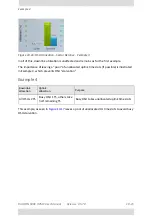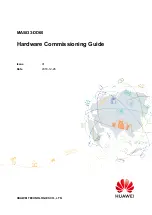
RADWIN
5000
HPMP
User
Manual
Release
3.5.70
11
‐
2
What
You
Need
Changing
any
of
VLAN,
MIR,
QoS,
fixed
rate,
Spatial
Multiplexing/Diversity
antenna
mode
for
one
configured
HSU
at
a
given
level,
changes
all
other
HSUs
at
that
level.
If
you
add
a
new
HSU
to
a
sector
(by
direct
connection)
at
a
given
level,
at
sync
time,
it
will
acquire
the
existing
parameters
for
that
level.
A
HMU
must
be
able
to
send
and
receive
service
traffic
while
moving.
To
avoid
service
“glitches”
while
switching
between
successive
HBSs,
the
HBS
hand
‐
over
time
must
be
very
small.
For
RADWIN
5000
HBSs
it
is
typically
less
than
500
ms,
depending
on
selection
of
Mobility
channels.
A
HMU
detects
that
it
is
time
to
seek
the
next
HBS
when
its
rate
drops
below
a
predefined
minimum
capacity
threshold
based
on
a
minimum
supported
rate.
The
HBS
chosen
will
be
the
first
found
offering
an
RSS
level
above
a
minimum
threshold
(by
default
‐
60
dBm),
which
you
can
configure
for
each
HMU.
If
no
HBS
can
be
found
satisfying
the
latter
criterion,
then
the
HSU
will
sync
with
the
HBS
that
has
the
highest
RSS
level
(even
though
it
is
below
the
RSS
Threshold).
It
is
up
to
the
Mobility
Project
RF
planners
to
ensure
that
HBSs
are
spaced
with
coverage
overlap
so
that
on
the
one
hand
the
HSU
RSS
level
does
not
fall
so
low
that
it
loses
synchronization
between
HBSs
and
on
the
other
hand,
successive
HBSs
do
not
interfere
with
one
another.
In
a
Mobility
project,
it
is
fairly
typical
to
use
a
fixed
channel
at
each
HBS
and
to
have
the
HSUs
configured
to
use
the
group
of
channels
used
by
the
HBSs
so
as
to
minimize
hand
‐
over
time.
What
You
Need
The
RADWIN
5000
Mobility
products
are
different
from
the
fixed/nomadic
products.
They
have
different
part
numbers.
Ensure
that
your
HBS
and
HSUs
as
delivered
are
the
Mobility
models.
Each
sector
comes
with
a
pre
‐
installed
operating
band.
You
can
change
it
in
the
usual
way.
If
you
do
ensure
than
each
of
the
HSUs
is
changed.
Alternatively
(better),
bring
up
the
sector
as
‐
is
and
change
the
band
sector
‐
wide.
Getting
Started
We
will
create
a
sector
with
three
HMUs.
There
is
no
difference
in
the
log
‐
on
procedure
to
the
HBS.
To
avoid
needless
repetition
and
issues
not
really
relevant
to
this
chapter,
we
will
start
out
with
the
HBS
and
the
HMUs
set
to
there
factory
defaults
except
for
the
IP
addresses.
We
will
maintain
the
IP
addresses
used
in
the
previous
chapters.
In
practice,
the
IP
addresses
of
sector
element
may
well
be
configured
using
Direct
or
Local
Connection
prior
to
reproduction
of
sector
parameters
from
a
“template”
sector
(such
as
we
are
creating)
and
most
likely
before
deployment
in
the
field.
Further
we
will
not
make
any
use
of
the
Map
view
in
this
chapter.
Once
again,
in
practice,
a
Mobile
system
would
be
managed
from
a
NOC
using
an
enterprise
standard
NMS.
Summary of Contents for 5000 HPMP
Page 1: ...USER MANUAL RADWIN 5000 POINT TO MULTIPOINT BROADBAND WIRELESS Release 3 5 70...
Page 21: ...Part 1 Basic Installation Release 3 5 70...
Page 69: ...Part 2 Sector Installation Release 3 5 70...
Page 155: ...Part 3 Sector Management Release 3 5 70...
Page 197: ...RADWIN 5000 HPMP User Manual Release 3 5 70 8 42 Nomadic...
Page 252: ...RADWIN 5000 HPMP User Manual Release 3 5 70 11 8 Registering HMUs 3 Open the Air Interface tab...
Page 290: ...Part 4 Site Synchronization Release 3 5 70...
Page 319: ...RADWIN 5000 HPMP User Manual Release 3 5 70 16 7 Configuring the GSU...
Page 320: ...Part 5 Advanced Installation Topics Release 3 5 70...
Page 354: ...Part 6 Field Installation Topics Release 3 5 70...
Page 396: ...Part 7 Product Reference Release 3 5 70...
Page 517: ......
















































